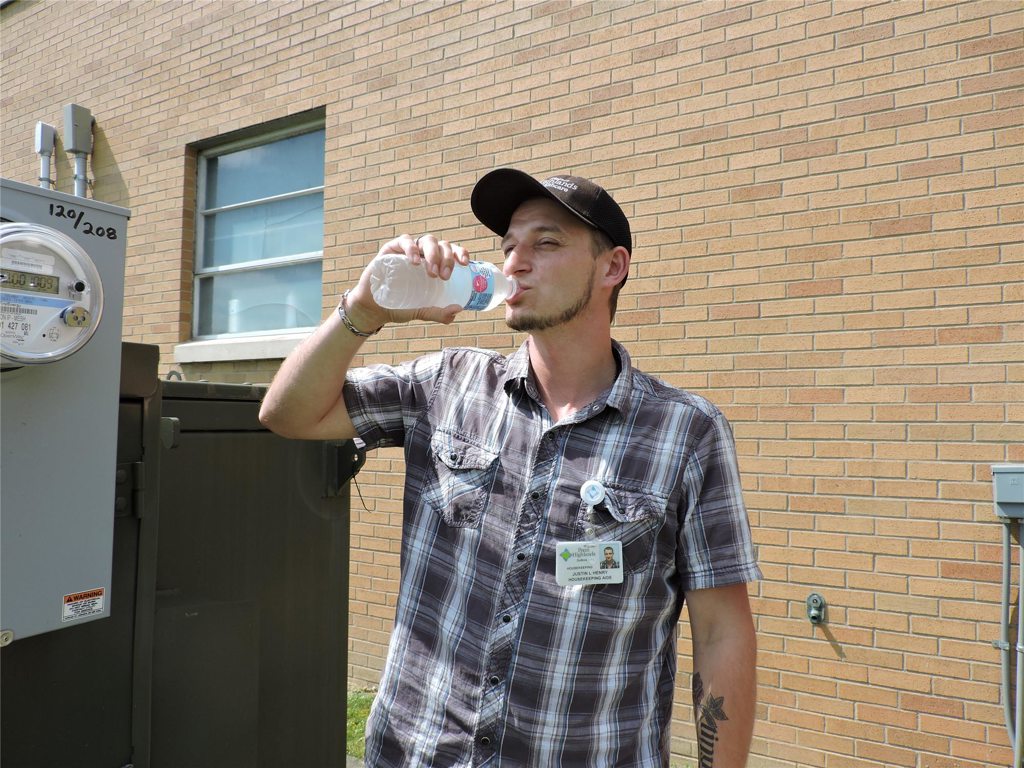
MFP Projectsv
The old saying goes that it’s summertime and the living is easy.
But it’s not easy for some when you’re making a living in the heat.
“Heat puts stress on your body,” David McAllister, Occupational Health manager at Penn Highlands Healthcare and authorized OSHA outreach trainer, said. “This is especially true for those working in the heat this summer.”
In general, “the body tries to maintain a constant internal temperature. When the internal temperature rises, the body attempts to get rid of excess heat by increasing blood flow to skin surface and sweating,” he said. This is why people turn red even without sun exposure.
To compensate for the increased blood flow to the skin surface, the body’s blood flow to other areas is reduced. This includes the brain and active muscles, which leads to reduced mental alertness and comprehension, fatigue and loss of strength. “And this reduced alertness and fatigue can lead to a higher rate of mistakes and injuries,” McAllister said. “Just the excess sweat can cause slipperiness and lead to an accident.” For example, a person using a tool could have the tool slip and cause injury, or a person holding onto something for stability could lose his or her grip.
Heat doesn’t just affect those who work outside. Not every building is air-conditioned. Large factories and mechanic garages just physically can’t be cooled efficiently. Even places with air conditioning can have failures, and high temperatures can reduce the effectiveness of the cooling system.
Heat can also cause illnesses, such as heat stroke, heat exhaustion, heat cramps, dehydration or heat rash. Though they vary in severity, they all require care.
Heat stroke
Heat stroke is the total breakdown of the body’s cooling system. Signs of it include:
- The body’s temperature is 103 degrees;
- Sweating stops;
- Skin is hot, red and dry;
- Headaches;
- Dizziness;
- Weakness;
- Rapid pulse;
- Chills;
- Difficulty breathing.
If left untreated, it can lead to delirium and unconsciousness. Heat stroke is a medical emergency. It may result in death if not treated, and 4,000 Americans die of it each year.
If you think someone is affected by heat stroke, call 9-1-1 and begin to cool him or her. Move the person to a cool area; provide a small cup of water if the person can drink. Loosen or remove clothing, and cool the person with water or ice. Fan him or her vigorously to improve evaporation.
Heat exhaustion
Heat exhaustion is caused by the excessive loss of water and salt. Bodies need salt for nerves and muscles to work correctly and keep the right balance of fluids in your body. Signs and symptoms of heat exhaustion include:
- Heavy sweating;
- Intense thirst;
- Skin is pale and cool;
- Rapid pulse, fatigue or weakness;
- Nausea and vomiting;
- Headache;
- Blurred vision;
- Fainting.
It is treated by taking the person into a cooler area to rest with legs elevated. Clothing should be loosened. The person should be given fluids, cooled with water and fanned.
Heat cramps
Heat cramps are caused by a loss of salt from sweating. The signs are simple:
- Painful spasms in arms, legs and abdomen;
- Hot, moist skin.
Cramps are treated with rest, drinking water and massaging the cramped areas.
Dehydration
Dehydration is caused by excessive fluid loss. Signs and symptoms include:
- Fatigue;
- Weakness;
- Dry mouth.
The treatment is simple – drink fluids and ingest a salt replacement. Salt replacement may come in a sports drink with high sodium or by eating a food with lots of salt, such as chips.
Dehydration occurs easily in all ages. It affects older adults often, and it can lead to hospitalization.
Heat rash
Heat rash is inflamed skin caused by heat. Signs and symptoms include:
- Rash with pink pimples;
- Itching;
- Tingling.
Treatment is easy. Cleanse the area, dry it and apply calamine or other lotions.
How can you prevent heat-related illnesses?
“Know the factors that increase risk,” McAllister said. “Know the environment you are working in, know your body’s condition and know the work you are doing. Think about the air temperature, the amount of humidity, the amount of sun exposure and air circulation.”
Wear clothing that is appropriate. Think about its weight; can you wear lighter weight clothing safely? Pick light colors over dark ones. And know that you will wear your protective equipment on the job. Factor in time to cool yourself or drink more if you know wearing it makes you sweat more.
Schedule tasks with some consideration of the heat. Work so long, then rest. “Do your heaviest tasks in the early morning or dusk,” McAllister said.
What are your personal factors? Think about your age, your weight and how fit you are. Have you ever had a heat-related illness before? The use of drugs, alcohol, caffeine and medications will also matter.
When you are working in the heat, don’t rely on your thirst before you drink fluids. Drink 5-7 ounces every 20 minutes. Water is best. Drinks with caffeine, such as sodas, coffee or tea, will work to dehydrate you as caffeine creates more urine than those without. For those working around the house, the same holds true for alcohol; it’s a diuretic.
Eventually, as summer goes on, you will become more used to the heat. It takes about 3-5 days to acclimate to a new temperature. “Be careful when returning home from a vacation,” McAllister said. “It may take longer to get back to where you were before you left.”
If you have any questions or concerns about work safety or would like a presentation about it, call McAllister or Penn Highlands Occupational Health staff at 814-788-5647.
